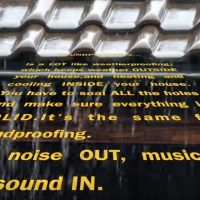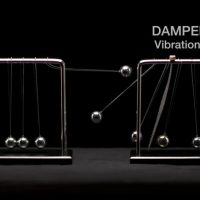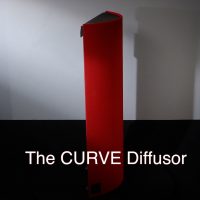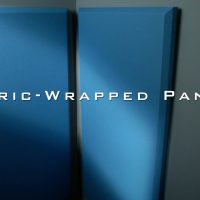An Acoustic Primer (AcoGeo)
An Acoustic Primer (AcoGeo) Video Transcript
Hi, I’m John Calder of Acoustic Geometry. Let’s talk about “Acoustics”, which is basically “how sound works in rooms”, and it seems complicated.
So, let’s make it simpler.
Most rooms have flat walls and ceilings, and sound bounces off of these. So how does that affect the sound?
I’ll use these two Nerf guns to demonstrate.
I’ve got this one aimed so this disc goes directly to the ear – this disc represents Direct Sound.
I’ve got this one aimed so that disc bounces off the wall, and it represents Reflected Sound. I’ll shoot them both at the same time.
Reflected Sound arrives at our ears later than Direct Sound, even though it started out at the same time. Because it’s travelling farther.
And this is only one flat surface – there are at least six in the average room, and that’s a lot of reflected sound.
But why is reflected sound bad? I’ll demonstrate using these two identical patterns. The BLUE pattern represents Direct Sound Waves and the RED represents Reflected Sound Waves.
They start out together. But when I move the red one backwards, like a delayed sound reflection, it creates Destructive Interference patterns, which changes the original sound wave.
Here’s the problem: original sound waves are distorted by strong later-arriving reflections.
Also, sound wave energy is really fast, about 1130 feet per second. A sound wave will bounce back and forth between these two walls about 60 times in one second
Sound travels so fast, it fills a room almost instantly. And this is only one bounce angle – every room has thousands.
The Big Acoustics Question: How can we make our room sound better? Remember our Nerf guns? I’ll shoot these at the same time, again representing a sound wave bouncing off a wall.
Both discs bounce together in the same direction, which means the reflected sound is at full strength.
Now let’s the first of our two acoustical tools – an Absorber to reduce the strength of sound bounces.
To a sound wave, an absorber looks a little like a hole in the wall, so some of the energy doesn’t come back.
An absorber works by reducing the strength of reflected sound that would otherwise cause more destructive interference.
But if we use only absorbers in a room, it makes it sound dull and unnatural. Historically, humans don’t like overly-absorbent rooms.
So, let’s use the second of our two acoustical tools – the curved-surface Diffusor. It also reduces the strength of sound bounces.
A diffusor works by scattering the sound reflections in different directions, smoothing out destructive interferences throughout the room.
Room Acoustics are greatly improved using a combination of absorption and diffusion.
It’s all about reducing those flat-surface reflections. Use a combination of absorbers and diffusors, and your room will sound a lot more natural. Thanks for watching.
Your Brain On Sound
Hi, I’m John Calder of Acoustic Geometry. When we talk about “Acoustics”, we should talk about “your brain on sound”, because our sense of hearing – ears and brain – is sensitive to acoustics. And hearing is a survival tool.
You’re hunting for lunch thirty-thousand years ago. You hear a twig snap…If your brain doesn’t tell you instantly which direction to run, you might be lunch.
We’re always listening for potential danger. Short, sharp sounds called “transients” – like twig snaps – are mostly what we listen for.
Transients help your brain create a picture of where, what, and how big – a sound image. By comparing timing, loudness, and tone differences between ears, your brain knows whether it’s a [tiger roar] or a [cat meow].
With a pair of microphones recording a symphony, or me talking, we record the timing, loudness, and tone differences between each mic – stereophonically – for accurate sound image playback.
Our brains are happiest when we hear accurate sound images played back with electronics, speakers, and acoustics that don’t damage timing, loudness, and tone, also known as phase, amplitude, and harmonics.
Here’s BIG POINT Number One: Good room acoustics are critical for accurate sound imaging.
In our video “How Sound Works (In Rooms)”, we show that flat-surface reflections damage the timing, loudness, and tone of sound– and create the need for acoustic treatments.
But some acoustic treatments are part of the problem, because they also damage timing, loudness, and tone.
That includes absorbers. Too many absorbers can kill the sound energy in your room – your ambience.
Too much absorption creates a mismatch with what our brains expect to hear – and it diminishes our pitch perception.
That leaves us with the other room treatment – diffusors – which don’t kill ambience or pitch perception. But there is a problem.
Phase-shift diffusors, like quadratic-residue designs, work by distorting the timing, or phase, relationships within reflections, which will damage the sound image.
That’s a problem, because It messes with the twig snap. Our brains are more sensitive to phase than frequency for sound location – it’s a survival tool.
Here’s BIG POINT Number Two: timing accuracy, called phase coherence, is essential for recording and hearing accurate sound images.
Can we use common sense to improve our sense of hearing? Sure! Use acoustic treatments that preserve timing, loudness, and tone relationships.
Fortunately, there is an acoustic treatment that preserves them – phase-coherent diffusion.
By the way, this isn’t new science – RCA Studios used phase-coherent diffusion back in the nineteen-forties.
Phase-coherent diffusors smoothly spread out reflections, reducing hot spots and allowing us to use less absorption. This improves our hearing – it’s the way our brains work.
Our brains are really amazing, capable of hearing location, size, and type of sound almost instantly, given the right acoustics.
Treat your room with Acoustic Geometry Curve Diffusors – your brain will be happier! Thanks for watching.
Acoustic Panels – What & Where
Hi, I’m John Calder of Acoustic Geometry. We talk with thousands of people about Acoustic Panels, and they all ask us “What and Where?”
So, what are acoustic panels? There are two types: absorbers and diffusors, and they’re both important to improving the sound of your room.
We’ll start by finding the First Reflection Points, which are simply the places sound bounces after leaving your speakers on the way to your ears.
First Reflection Points have the first and worst effect on sound and rooms. I’ll use my nerf gun to find my first reflection point on this wall. Of course, you may not want to find your First Reflection Points like this.
So, here’s an easier way. Get a handheld mirror, and an assistant.
Slide the mirror along the wall until your assistant sees the speaker’s tweeter. Mark that spot with painter’s tape, then repeat on the other side
Now you’ve marked your First Reflection Points on the walls. Which panels go there? Lots of people put absorber panels at their First Reflection Points, and that’s okay.
But a better option to use our Medium Curve Diffusors in those pesky First Reflection Points. It’ll make your stereo sound stage wider and more focused, because our diffusors are phase coherent.
Flat surface reflections happen on all four walls, so let’s place one Small Curve diffusor on the back wall and one on the front wall. We’ve mounted the front wall diffusor horizontally because sound moves in three dimensions and it fits with the TV.
Because corners make sound bounces worse, we’ll use a fabric-wrapped absorber panel in each corner. Two in front reduce side-to-side reflections, and two in back reduce front-to-back reflections.
That’s it for the basics. These eight acoustic panels will definitely improve the sound of your room and might be all you need.
All rooms are different, and your room may need more sound control. So, let’s look at the next group of treatments.
The ceiling is a flat surface area and should be treated. Ceiling absorber panels are called Clouds. Two are placed at the ceiling First Reflection Points, and two over your seating area,
or you could use our Silk Metal Absorbing Tiles if you have a drop-in ceiling grid. These are cutting-edge microperf technology.
We’re also adding a fabric-wrapped absorber panel in each corner, further reducing corner sound problems.
And we’ll add one more Medium Curve Diffusor on each side at right angles to your seating position, which is where the most annoying flutter echoes occur. And that completes our first two groups of acoustic treatments.
There’s one more group of improvements, if needed. Place a horizontally-mounted small curve diffusor between each of the 2 sets of side-wall Medium Curves. And place our curve corner traps in any two of your corners. You can also add 2 to 4 more clouds.
As you can see, you don’t need to treat every square foot to have great acoustics. Remember: your panels and layout will depend on size and the shape of your room, as well as windows and doors.
Our terrific Acoustic Geometry dealers are always happy to talk about our products with you. Call or click! They’re listed on our website. Thanks for watching.



 What’s First?
What’s First? What Is Soundproofing?
What Is Soundproofing? Curve Diffusor Panel Introduction
Curve Diffusor Panel Introduction Fabric-Wrapped Panels Introduction
Fabric-Wrapped Panels Introduction